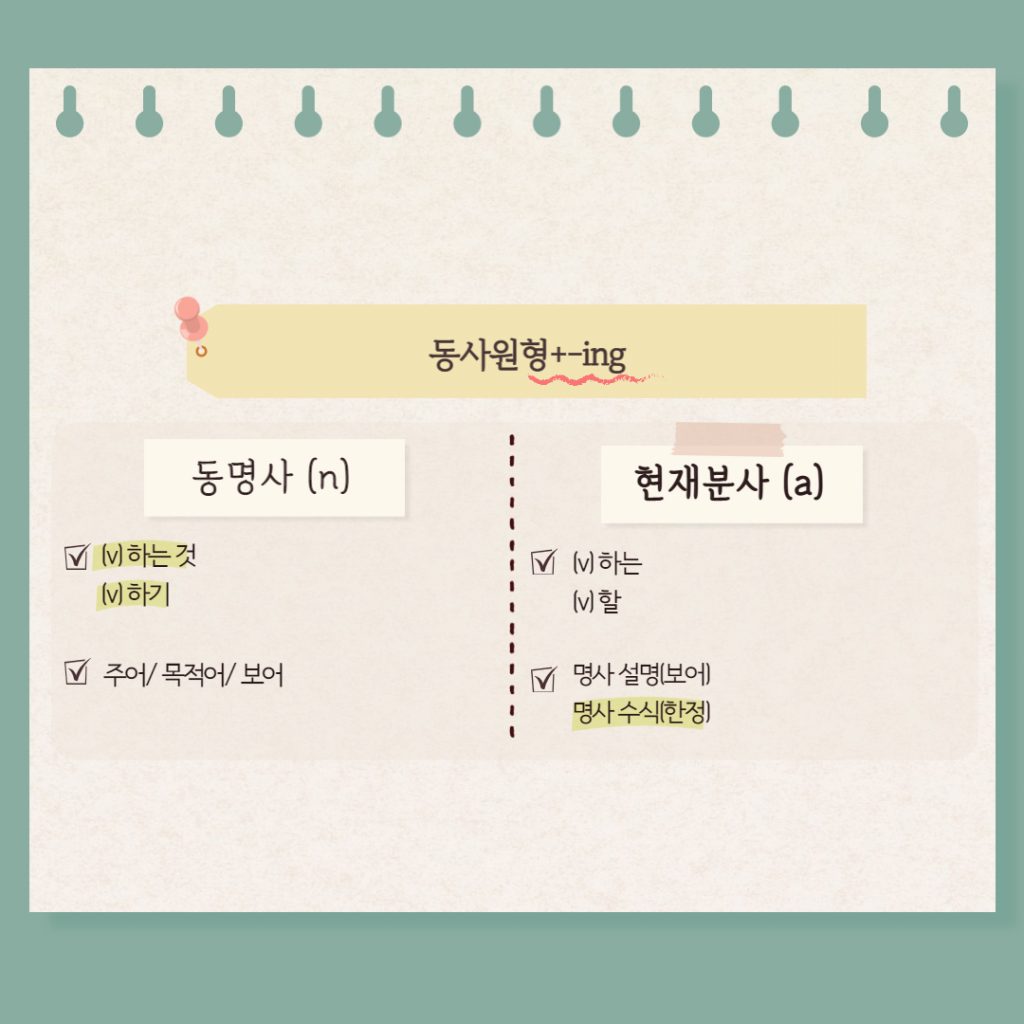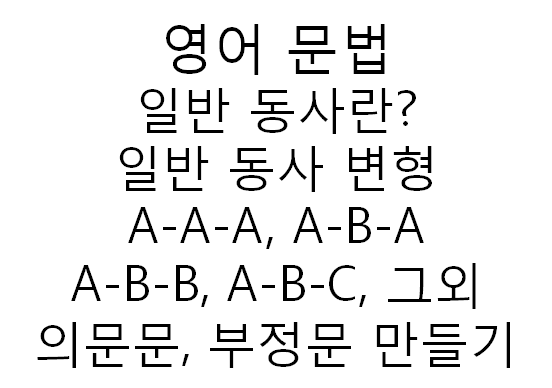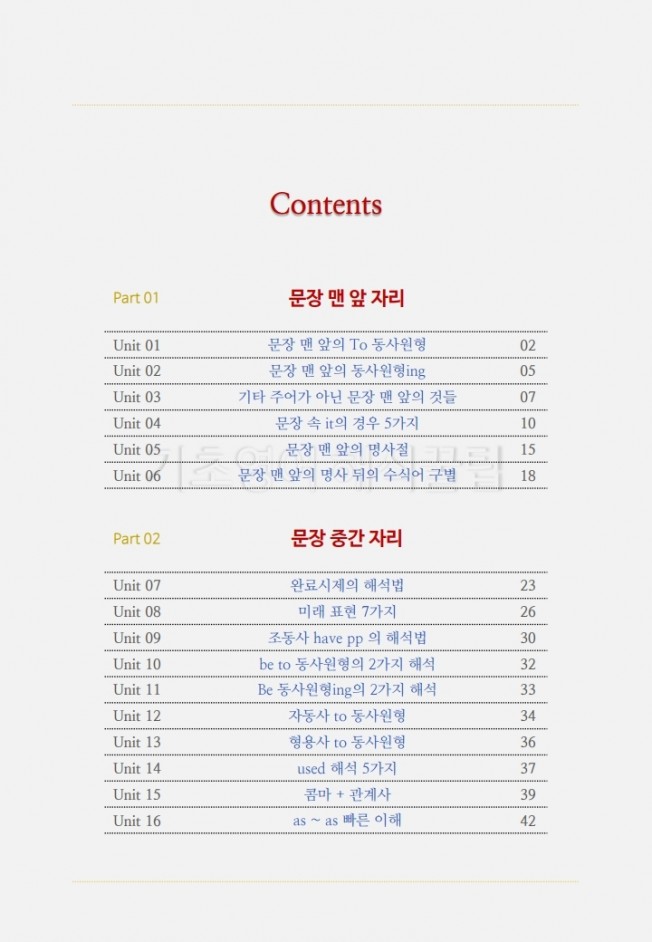동사원형이란
동사원형은 한국어에서 동사를 기본형으로 나타내는 형태입니다. 모든 동사는 원형 형태를 가지고 있으며, 원형은 동사의 기본 형태로서 어미가 없는 동사입니다. 동사의 원형은 동사의 다양한 활용 형태와 과거, 미래 시제 형태를 결정짓는 중요한 역할을 합니다. 따라서 동사를 이해하고 사용하기 위해서는 동사의 원형에 대한 이해가 필요합니다.
동사원형의 정의와 역할
동사원형은 동사의 원형적인 형태로서, 자음이나 모음의 변화 없이 가장 기본적인 형태입니다. 동사의 원형은 어느 시간적인 상황에든 적용될 수 있습니다. 예를 들어, “가다”라는 동사의 원형은 “가다”로서 어떤 시간이든 사용될 수 있습니다. 동사의 다른 형태들과는 달리 원형은 어미가 없으며, 어간이라고 불리는 부분만을 가지고 있습니다.
동사의 역할은 문장에서 동작이나 상태를 나타내는 역할을 합니다. 동사 원형은 기본적으로 동작이나 상태의 정보를 제공하며, 이 정보는 다양한 활용 형태에서 다른 시제, 어미, 부사 등과 결합하여 문맥적인 의미를 완성합니다.
동사원형의 형성 규칙과 예제
동사의 원형 형성은 일반적으로 다음과 같은 규칙을 따릅니다.
– 어간 + 어미
– 어간 + 하다
– 어간 + 다
예를 들어, “먹다”라는 동사의 원형은 “먹”이며, “이야기하다”라는 동사의 원형은 “이야기”입니다.
동사원형은 다양한 용도와 활용법
동사원형은 다양한 용도와 활용법이 있습니다. 실제로 동사의 원형은 다른 형태들의 기반이 되기 때문에 중요한 역할을 합니다.
1. 다양한 시제 표현: 동사원형은 다양한 시제 형태를 나타내기 위한 기반 형태입니다. 다른 어미나 조사, 부사와 결합하여 과거, 현재, 미래 시제의 동사 변화를 나타낼 수 있습니다.
2. 다양한 활용 형태: 동사원형은 다양한 활용 형태를 통해 다른 의미와 표현을 갖게 됩니다. 예를 들어, 동사 원형 “보다”는 “본다”, “볼게요”, “봅니다” 등 다양한 형태로 활용될 수 있습니다.
3. 문장 구성: 동사원형은 문장의 핵심으로 사용되며, 주어나 목적어와 일치하여 문장을 완성시키는 역할을 합니다.
동사원형과 동사 어간의 차이
동사원형과 동사 어간은 동사의 형태에서 중요한 부분입니다. 동사 원형은 동사 어간을 포함하고 있으며, 동사 어간은 원형에서 어미가 제거된 형태입니다. 동사 어간은 문장에서 동사의 원본 형태를 나타내며, 다양한 활용 형태와 시제 변화에 따른 어미와 결합하여 다양한 의미를 형성합니다.
예를 들어, “먹다”라는 동사의 원형은 “먹”이며, 여기서 “먹”은 동사의 어간입니다. 동사 어간에 다양한 어미를 붙여 다양한 시제와 의미를 표현할 수 있습니다. 예를 들어, “먹는다”, “먹을게요”, “먹고 있다” 등 다양한 형태로 동사 어간이 변화하면서 다양한 의미를 형성합니다.
동사원형에서의 어미와 어간의 분리
동사원형에서 어미와 어간을 구분하는 것은 중요합니다. 어미는 문맥에 따라 다양한 변화를 겪는 형태소로, 기본적으로 동사 어간 뒤에 결합하여 다양한 의미를 형성합니다. 동사 어간은 동사의 원형을 나타내는 부분으로써, 어미가 결합되지 않은 가장 기본 형태라고 할 수 있습니다.
예를 들어, “먹는다”라는 문장에서 “먹”은 어간이고, “는”은 어미입니다. “먹는다”는 “먹다”라는 원형에서 어미 “는”이 결합한 형태로서 “먹는”이라는 동사 어간과 어미의 결합으로 나타난 형태입니다.
동사원형과 활용형태의 관계
동사원형과 동사의 활용 형태는 서로 연관되어 있습니다. 동사의 원형에서 어간의 변화와 어미의 변화로 다양한 활용 형태를 나타낼 수 있습니다. 동사의 원형은 다양한 활용 형태들의 기반이 되며, 활용 형태는 어간과 어미의 결합에 따라서 다양한 시제, 의미를 형성합니다.
예를 들어, “보다”라는 동사의 원형은 “보”이고, “보”에 다양한 어미를 결합하여 “본다”, “볼게요”, “봅니다” 등의 형태로 변화할 수 있습니다. 이렇게 동사원형에서 활용형태로 변화할 때에는 어간과 어미의 결합에 따라 시제와 의미가 결정됩니다.
동사 원형 변화에 따른 의미 변화
동사의 원형 변화는 문맥에 따라 다양한 의미 변화를 가져올 수 있습니다. 동사의 원형은 다양한 활용 형태를 이루기 위해 다양한 어미와 결합하여 다양한 의미를 형성합니다.
예를 들어, “가다”라는 동사의 원형은 “가”이며, 이때에 다른 어미와 결합하여 “갈게요”, “간다”, “갔다” 등의 형태로 사용될 수 있습니다. 이렇게 동사의 원형 변화에 따라 동사의 시제 변화와 더불어 의미 변화가 이루어집니다.
동사원형의 주어·목적어와의 일치 관계
동사원형은 주어와 목적어와 일치하는 관계를 갖습니다. 한국어에서 주어와 목적어는 문장에서 중요한 구성 요소로, 주어와 목적어의 일치 여부에 따라 문장의 의미와 문법적 구조가 결정됩니다.
동사의 원형은 주로 주어와 일치하여 문장의 주어를 나타내는 역할을 합니다. 예를 들어, “나는 먹다”라는 문장에서 “나”는 주어이며, “먹다”는 동사 원형으로서 주어와 일치하는 형태입니다.
또한, 동사의 원형은 목적어와 일치하여 문장의 목적어를 나타내는 역할도 합니다. 예를 들어, “나는 사과를 먹다”라는 문장에서 “사과”는 목적어이며, “먹다”는 동사 원형으로서 목적어와 일치하는 형태입니다.
동사원형의 종류와 특징
동사의 원형은 다양한 종류와 특징을 갖고 있습니다. 동사의 종류에 따라 동사 원형의 형태와 활용 형태, 의미 등이 달라질 수 있습니다.
일반적으로 동사 원형은 자음 또는 모음으로 끝나는 형태를 가지고 있습니다. 예를 들어, “가다”, “먹다”, “웃다” 등이 대표적인 동사 원형의 형태입니다.
또한, 동사 원형은 원형 그대로 사용되는 경우도 있지만, 어떤 경우에는 다른 형태로 변화하여 사용될 수도 있습니다. 예를 들어, “하다”는 동사 원형인데, “한다”, “해요” 등의 형태로도 사용될 수 있습니다.
동사원형 예시:
– 먹다
– 가다
– 자다
– 보다
– 열다
동사원형 종류:
– ㄷ 불규칙 활용 (예: 묻다, 닫다)
– 용언화 하지 않은 명사, 형용사를 동사로 쓸 때 (예: 공부하다, 무섭다)
– 연결 어미 할 때 (예: 있다, 없다)
– “어떻게 할 수 없어서”에 사용되는 동사 (예: 사랑하다)
– 독립언어로서의 ‘야하다’ (예: 잠깐만요, 지금은 그럴 때가 아녀요)
– 비용을 말하는 말 (예: 100만원이 들다)
– 기본독립형 대명사 앞에 쓰여 ‘되다’와 유사한 느낌을 준다 (예: 저랑 놀다, 버려도 되다)
동사원형 약자:
– 다
동사원형 모음:
– ㅏ
– ㅗ
– ㅜ
동사원형 작가:
– 윤동주
– 한강
– 조지주
동사원형 영어 뜻:
– to do
– to go
– to sleep
– to see
– to open
동사원형 r:
– rub
– read
– ring
– rest
– run
be 동사원형 동사원형이란:
– be 동사원형은 “이다”라는 동사의 원형이며, 그 자체로 사용될 때에는 주로 명사나 형용사 뒤에 올 수 있습니다. 예를 들어, “나는 학생이다”라는 문장에서 “이다”는 “학생”이라는 명사 뒤에 온 be 동사 원형입니다. Be 동사 원형은 문장에서 등장하는 주어의 성질을 나타내는 역할을 합니다.
사용자가 검색한 키워드: 동사원형이란 동사원형 예시, 동사원형 종류, 동사원형 약자, 동사원형 모음, 동사원형 작가, 동사원형 영어 뜻, 동사원형 r, be 동사원형
Categories: Top 95 동사원형이란
동사원형은 뭐지? 동원참치? |고딸영어| 기초영문법| 영문법 용어
여기에서 자세히 보기: taomalumdongtien.net
동사원형 예시
동사원형 (verb infinitive) is the basic form of a verb in Korean. It is an unconjugated form that does not indicate tense, honorifics, or politeness levels. Understanding 동사원형 is crucial for learning Korean grammar and constructing sentences properly. In this article, we will explore various examples of 동사원형 and provide useful tips to help you use them correctly. So, let’s delve into the world of 동사원형 예시!
Example Sentences:
1. 사다 (to buy)
– 나는 과일을 사러 시장에 갔다. (I went to the market to buy fruits.)
– 지난 주, 형은 새 신발을 사려고 많이 돈을 저금했다. (Last week, my brother saved a lot of money to buy new shoes.)
2. 가다 (to go)
– 올해 여름에 우린 바다로 휴가를 가려고 해요. (We plan to go on vacation to the beach this summer.)
– 저는 지금 집에 돌아가려고 하는데, 같이 오실래요? (I’m about to go home now, would you like to come along?)
3. 말하다 (to speak)
– 선생님은 항상 크게 말하라고 말씀하셨다. (The teacher always told us to speak loud.)
– 오늘 회의에서 중요한 이야기를 하려고 했는데 시간이 없어서 못했어요. (I wanted to talk about an important matter in today’s meeting, but couldn’t due to lack of time.)
4. 읽다 (to read)
– 독서는 지식을 얻기 위해 한 가지 좋은 방법이다. (Reading is one of the good ways to gain knowledge.)
– 도서관에 가서 좋은 책을 찾아 읽으려고 해요. (I plan to go to the library and find a good book to read.)
5. 먹다 (to eat)
– 식사하기 전에 손을 씻는 것은 건강을 지키기 위한 아주 중요한 습관이다. (Washing hands before meals is a very important habit for maintaining good health.)
– 오늘 나는 같이 맛있는 저녁 식사를 하러 갈 친구를 초대했다. (Today, I invited a friend to join me for a delicious dinner.)
6. 보다 (to see)
– 이 텔레비전에 나오는 영화를 보려고 기다렸어요. (I’ve been waiting to watch the movie that is being shown on this television.)
– 조금만 더 노력하면 훨씬 더 멋진 세상을 볼 수 있을 것이다. (If we put in a little more effort, we can see a much more beautiful world.)
7. 듣다 (to listen)
– 음악을 듣는 것은 힐링을 위한 최고의 방법 중 하나이다. (Listening to music is one of the best ways to heal.)
– 오늘은 학교에 가지 않아도 될 것 같아서 오디오북을 듣기로 했다. (Today, I decided to listen to an audiobook since it seems like I don’t have to go to school.)
8. 쓰다 (to write)
– 내일 시험을 대비해서 방대한 양의 노트를 쓰려고 계획 중이다. (I’m planning to write a massive amount of notes to prepare for tomorrow’s exam.)
– 작년에 저는 일기를 쓰는 습관을 만들려고 노력했었어요. (Last year, I tried to make a habit of writing a diary.)
FAQs:
Q1: Can 동사원형 be used in sentences as the main verb?
A1: Yes, 동사원형 can function as the main verb in a sentence. For example, “여자친구를 만나러 가다” (to go meet a girlfriend) or “책을 읽다” (to read a book) are cases where 동사원형 is used as the main verb.
Q2: Can 동사원형 be used with verb endings?
A2: No, 동사원형 is the unconjugated form of a verb and cannot be used with verb endings. To make a sentence grammatically correct, the verb endings should be attached to 동사원형. For example, “먹어요” (eating), “갑니다” (going), or “말해주세요” (please speak).
Q3: Can 동사원형 be modified with adverbs or adjectives?
A3: Yes, 동사원형 can be modified by adverbs or adjectives. Adverbs can describe the verbs directly, such as “크게 말하다” (to speak loudly), while adjectives can describe nouns or pronouns related to the verb, such as “맛있는 저녁 식사” (delicious dinner) modifying “먹다” (to eat).
Q4: Is there any difference between the use of 동사원형 in speaking and writing?
A4: Generally, there is no significant difference in the use of 동사원형 between speaking and writing. However, in formal writing, it is more common to use verb endings rather than 동사원형 to convey specific tenses, honorifics, or politeness levels.
Q5: How can I remember the 동사원형 of verbs?
A5: Vocabulary is an important aspect of language learning, and it’s helpful to practice and memorize verbs along with their 동사원형 forms. Flashcards, sentence drills, and consistent exposure to Korean language materials will aid in remembering the 동사원형 of verbs over time.
In conclusion, 동사원형 예시 (Verb Infinitive Examples) offers learners of the Korean language a glimpse into the fundamental form of a verb. By mastering 동사원형, one can construct grammatically correct sentences, express their thoughts accurately, and engage in effective communication. Remember, practice makes perfect, so keep exploring and utilizing 동사원형 in various contexts to strengthen your Korean language skills. Happy learning!
동사원형 종류
In the Korean language, verbs play a significant role in constructing sentences and conveying meaning. Understanding the different types of verb stems is vital for anyone learning Korean. This article will explore the various verb stem types in depth, providing a comprehensive guide for language learners. Additionally, the article will conclude with a frequently asked questions (FAQs) section to address common queries regarding verb stems.
Before delving into the various types of verb stems, it is crucial to understand the concept of a verb stem in Korean. In this language, verbs are divided into two main parts: the stem and the ending. The stem is the part of the verb that remains constant, while the ending changes depending on tense, formality, and other grammatical elements. Identifying the stem is fundamental to conjugating verbs correctly and understanding sentence structure.
1. Dictionary Form
The dictionary form, also known as the infinitive form, is the most basic form of a verb. It expresses an action or state without any additional conjugations or endings. Dictionary verbs typically end in -다 or -하다. For instance, the verb “to eat” is 먹다, and “to do” is 하다.
2. Past Tense Form
The past tense form denotes actions or states that occurred in the past. To form the past tense of a verb, take the dictionary form and replace the -다 ending with -았/었, depending on the verb’s final consonant. For example, the past tense of 먹다 (to eat) is 먹었다, and the past tense of 하다 (to do) is 했다.
3. Present Tense Form
The present tense form represents actions or states that occur in the present. To construct the present tense of most verbs, take the dictionary form and remove the -다 ending. However, some verbs require other changes. For instance, the present tense of 먹다 (to eat) is 먹고, and the present tense of 하다 (to do) is 한다.
4. Progressive Form
The progressive form indicates ongoing actions or states. To create the progressive form, take the present tense form of a verb and add -고 있다. For example, the progressive form of 먹다 (to eat) is 먹고 있다, and the progressive form of 하다 (to do) is 하고 있다.
5. Future Tense Form
The future tense form expresses actions or states that will occur in the future. To form the future tense, take the dictionary form of a verb and attach -(으)ㄹ 거예요 to the end. For instance, the future tense of 먹다 (to eat) is 먹을 거예요, and the future tense of 하다 (to do) is 할 거예요.
Now that we have explored the various types of verb stems, let’s address some common questions learners may have:
FAQs
Q1: Can verb stems be used independently in sentences?
A1: No, verb stems alone cannot form complete sentences. They require conjugation with appropriate endings, subject particles, and other components to create grammatically correct sentences.
Q2: Are there irregular verb stems in Korean?
A2: Yes, Korean does have irregular verb stems. While most verbs follow regular conjugation rules, certain verbs exhibit irregular stem changes in various tenses and forms. These irregularities should be learned separately.
Q3: Do all verb stems end in -다 or -하다?
A3: While many verbs do end in -다 or -하다, not all verbs follow this pattern. Some verbs end in other syllables, such as -르다. However, these irregularities can be learned through practice and exposure to the language.
Q4: Can verb stems change based on honorific or formal language?
A4: Yes, verb stems can change based on the level of formality or honorific speech. Different verb endings are used to address varying degrees of politeness or honor towards the listener or the subject of the sentence.
In conclusion, grasping the various types of verb stems in Korean is essential for effective communication in the language. By understanding the dictionary, past tense, present tense, progressive, and future tense forms, learners can construct sentences accurately and convey meaning appropriately. While verb stems may seem challenging at first, practice and exposure to the language will improve proficiency.
주제와 관련된 이미지 동사원형이란

동사원형이란 주제와 관련된 이미지 9개를 찾았습니다.
![기초영문법] 동사원형은 뭐지? 동사원형 구별하기 #동사원형 #동사원형의모습 #동사원형구별 - YouTube 기초영문법] 동사원형은 뭐지? 동사원형 구별하기 #동사원형 #동사원형의모습 #동사원형구별 - Youtube](https://i.ytimg.com/vi/5IWB00gPgoM/mqdefault.jpg)
![조동사 - Part 1] 종류 & 위치 + 조동사 뒤에는 왜 동사원형일까요? - YouTube 조동사 - Part 1] 종류 & 위치 + 조동사 뒤에는 왜 동사원형일까요? - Youtube](https://i.ytimg.com/vi/yMO2H3RGXlM/maxresdefault.jpg)
![영문법 기초편] Chapter 7. 일반동사의 현재형 과거형 (개념정리) 영문법 기초편] Chapter 7. 일반동사의 현재형 과거형 (개념정리)](https://blog.kakaocdn.net/dn/7WFfB/btqwQlAa27c/zUaijZTfhuXw2e8DMSRnn0/img.png)
![Basic Grammar ] 준동사 to 부정사 - 명사적 용법 Basic Grammar ] 준동사 To 부정사 - 명사적 용법](https://blog.kakaocdn.net/dn/bTe2Gg/btqA7pX35Iw/peU9wiTfS0jVmwdggh8t31/img.png)
![영어기초문법 63강] 현재진행형 만들기 be동사 + 동사원형ing - YouTube 영어기초문법 63강] 현재진행형 만들기 Be동사 + 동사원형Ing - Youtube](https://i.ytimg.com/vi/iyqnqBu8bRk/maxresdefault.jpg)
![원형 부정사 뜻과 개념, 동사 원형처럼 생겼지만 동사가 아닌 준동사![영어문법풀이 #38] - YouTube 원형 부정사 뜻과 개념, 동사 원형처럼 생겼지만 동사가 아닌 준동사![영어문법풀이 #38] - Youtube](https://i.ytimg.com/vi/QSXCkxIU3W4/maxresdefault.jpg)


![조동사 - Part 1] 종류 & 위치 + 조동사 뒤에는 왜 동사원형일까요? - YouTube 조동사 - Part 1] 종류 & 위치 + 조동사 뒤에는 왜 동사원형일까요? - Youtube](https://i.ytimg.com/vi/AfL0ztsV5M4/maxresdefault.jpg)
![[국내최초공개] 지각동사의 진정한 의미와 문장구조 원리를 설명해드립니다.(feat. 동사원형은 왜쓰는 거야?) - YouTube [국내최초공개] 지각동사의 진정한 의미와 문장구조 원리를 설명해드립니다.(Feat. 동사원형은 왜쓰는 거야?) - Youtube](https://i.ytimg.com/vi/36nsfdoYagg/maxresdefault.jpg)
![영문법 기초편] Chapter 7. 일반동사의 현재형 과거형 (개념정리) 영문법 기초편] Chapter 7. 일반동사의 현재형 과거형 (개념정리)](https://blog.kakaocdn.net/dn/EVHw1/btqwT1NvSvz/UvyEJQdVfBSN0rrbWwkFU0/img.png)

![필수 영어 문법 [혼합가정법이란 무었인가?] - YouTube 필수 영어 문법 [혼합가정법이란 무었인가?] - Youtube](https://i.ytimg.com/vi/QKNAKThwFkk/maxresdefault.jpg)


![영어의비밀] 동사원형이 도대체 뭐야? | I love it이 맞아요 I'm loving it이 맞아요? - YouTube 영어의비밀] 동사원형이 도대체 뭐야? | I Love It이 맞아요 I'M Loving It이 맞아요? - Youtube](https://i.ytimg.com/vi/fOF8UyDVZEE/maxresdefault.jpg)
![이야기 영문법]TO 부정사 명사적 용법 어디서 사용하나요? 이야기 영문법]To 부정사 명사적 용법 어디서 사용하나요?](https://blog.kakaocdn.net/dn/b3teSg/btqCFyUAKPs/RKUje7eki88eeHhCECoghK/img.png)









![조동사 개념과 뜻, Auxiliary verb? Modal verb? 법조동사? [영어문법풀이 #56] - YouTube 조동사 개념과 뜻, Auxiliary Verb? Modal Verb? 법조동사? [영어문법풀이 #56] - Youtube](https://i.ytimg.com/vi/eWhbOrinQSs/maxresdefault.jpg)
![20.02] 가정법 현재의 쓰임 20.02] 가정법 현재의 쓰임](https://img1.daumcdn.net/thumb/C176x176/?fname=https://blog.kakaocdn.net/dn/XRrZB/btqESpmi3Wn/Ax7d8kXo34wdkWQZSRX3W1/img.png)
![중학영어]09강. 보어로 쓰이는 to부정사, 동명사, 동사원형, 분사 중학영어]09강. 보어로 쓰이는 To부정사, 동명사, 동사원형, 분사](https://blog.kakaocdn.net/dn/oQiVD/btqSX8kz8hT/m8zQQN6QUnFJ5dkvJdnbM0/img.jpg)



![영문법 기초편] Chapter 7. 일반동사 현재형 과거형 (문제풀이) 영문법 기초편] Chapter 7. 일반동사 현재형 과거형 (문제풀이)](https://blog.kakaocdn.net/dn/oaqjn/btqwSmRqNQn/wf5qcgtoRkCr2WLd7tEQm0/img.png)
![국내최초공개] 지각동사의 진정한 의미와 문장구조 원리를 설명해드립니다.(feat. 동사원형은 왜쓰는 거야?) - YouTube 국내최초공개] 지각동사의 진정한 의미와 문장구조 원리를 설명해드립니다.(Feat. 동사원형은 왜쓰는 거야?) - Youtube](https://i.ytimg.com/vi/3CTjAzo2KTE/hqdefault.jpg)

![영작문법#17] 원인동사(사역동사 make, have, let) 완전 정리 영작문법#17] 원인동사(사역동사 Make, Have, Let) 완전 정리](https://img1.daumcdn.net/thumb/C176x176/?fname=https://blog.kakaocdn.net/dn/p8dfr/btqHelwgsph/7sSwIXdU5f4WRTKfyQDUPK/img.jpg)
![조동사+동사 원형은 틀린 규칙이다 [영어문법풀이 #55] 조동사+동사 원형은 틀린 규칙이다 [영어문법풀이 #55]](https://i.ytimg.com/vi/37Ml9aw6C5g/maxresdefault.jpg)




![영작문법#17] 원인동사(사역동사 make, have, let) 완전 정리 영작문법#17] 원인동사(사역동사 Make, Have, Let) 완전 정리](https://i1.daumcdn.net/thumb/C230x300/?fname=https://blog.kakaocdn.net/dn/21Cuh/btqJIMlhSwd/GxbRlp50b5ckJ3LNFrqq7k/img.jpg)
Article link: 동사원형이란.
주제에 대해 자세히 알아보기 동사원형이란.